
The fancy rat is the domesticated form of Rattus norvegicus, the brown rat, and the most common species of rat kept as a pet. The name fancy rat derives from the use of the adjective fancy for a hobby, also seen in "animal fancy", a hobby involving the appreciation, promotion, or breeding of pet or domestic animals. The offspring of wild-caught specimens, having become docile after having been bred for many generations, fall under the fancy type.
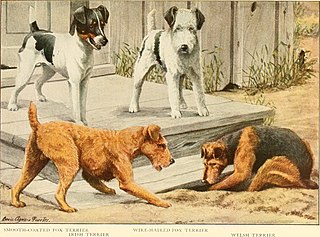
Terrier is a type of dog originally bred to hunt vermin. A terrier is a dog of any one of many breeds or landraces of the terrier type, which are typically small, wiry, game, and fearless. Terrier breeds vary greatly in size from just 1 kg (2 lb) to over 60 kg and are usually categorized by size or function. There are five different groups of terrier, with each group having different shapes and sizes.

The Staffordshire Bull Terrier, also called the Staffy or Stafford, is a purebred dog of small to medium size in the terrier group that originated in the northern parts of Birmingham and in the Black Country of Staffordshire, for which it is named. They descended from 19th-century bull terriers that were developed by crossing bulldogs with various terriers to create a generic type of dog generally known as bull and terriers. Staffords share the same ancestry with the modern Bull Terrier, although the two breeds developed along independent lines, and do not resemble each other. Modern Staffords more closely resemble the old type of bull terrier, and were first recognised as a purebred dog breed by The Kennel Club of Great Britain in 1935.

Bull-baiting is a blood sport involving putting a bull against dogs.
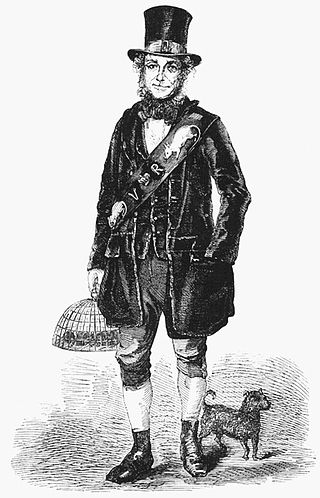
Jack Black was a rat-catcher and mole destroyer from Battersea, England during the middle of the nineteenth century. Black cut a striking figure in his self-made "uniform" of a green topcoat, scarlet waistcoat, and breeches, with a huge leather sash inset with cast-iron rats. Black promoted himself as the Queen's official rat-catcher, but he never held a royal warrant.

Fox Terriers are two different breeds of the terrier dog type: the Smooth Fox Terrier and the Wire Fox Terrier. Both of these breeds originated in the 19th century from a handful of dogs who are descended from earlier varieties of British terriers, and are related to other modern white terrier breeds. In addition, a number of breeds have diverged from these two main types of fox terrier and have been recognised separately, including the Jack Russell Terrier, Miniature Fox Terrier and Rat Terrier. The Wire and Smooth Fox Terriers share similar characteristics, the main differences being in the coat and markings. They have been successful in conformation shows, more prominently in America than their homeland.
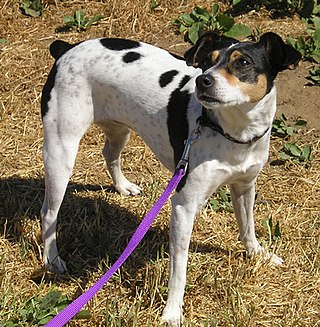
The Rat Terrier is an American dog breed with a background as a farm dog and hunting companion. They share much ancestry with the small hunting dogs known as feists. Common throughout family farms in the 1920s and 1930s, they are now recognized by the United and American Kennel Clubs and are considered a rare breed. Rat Terrier are an intelligent and active breed that can be kept both for pest control and as a family pet.

The English Toy Terrier is a small breed of terrier in the toy dog group.
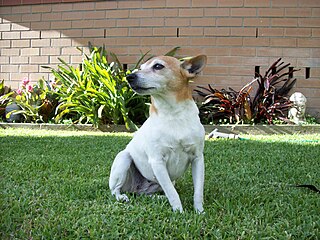
The Miniature Fox Terrier is a small, fine, lightweight working terrier developed as a hunting dog and vermin router. It is known colloquially in its native Australia as the “Mini Foxie”.

A rat-catcher is a person who kills or captures rats as a professional form of pest control. Keeping the rat population under control was practiced in Europe to prevent the spread of diseases, most notoriously the Black Death, and to prevent damage to food supplies. In modern developed countries, such a professional is otherwise known as a pest control operative or pest exterminator.

The Manchester Terrier is a breed of dog of the smooth-haired terrier type. It was first bred in the 19th century to control vermin, notably rats, at which it excelled. So efficient at the task was it that it often appeared in rat-baiting pits until that sport, which had effectively been illegal in the UK since 1835, finally died out at the beginning of the 20th century.

A fancy mouse is a domesticated form of the house mouse, one of many mice species, usually kept as a type of pocket pet. Fancy mice have also been specially bred for exhibiting, with shows being held internationally. A pet mouse is inexpensive compared to larger pets, and even many other pet rodents, but mice are comparatively short-lived: typically only 2 to 3 years.

Bulldogs are a type of dog that were traditionally used for the blood sports of baiting and dog fighting, but today are kept for other purposes, including companion dogs, guard dogs and catch dogs. Bulldogs are typically stocky, powerful, square-built animals with large, strong, brachycephalic-type muzzles. "Bull" is a reference that originated in England that refers to the sport of bull baiting, which was a national sport in England between the 13th and 18th century. It is believed bulldogs were developed during the 16th century in the Elizabethan era from the larger mastiffs, as smaller, more compact dogs were better suited for baiting.

Rat-baiting is a blood sport that involves releasing captured rats in an enclosed space with spectators betting on how long a dog, usually a terrier, takes to kill the rats. Often, two dogs competed, with the winner receiving a cash prize. It is now illegal in most countries.

The Ratonero Bodeguero Andaluz is a Spanish breed of dog of the terrier type. Its name reflects its main occupation: hunting rats and mice hidden between barrels in the wineries of Andalusia in Spain. It was recognised as an indigenous Spanish breed in 2000 by the Spanish Ministry of Agriculture and by the Spanish Kennel Club, the Real Sociedad Canina de España.

Bull and terrier was a common name for bulldog and terrier crossbreeds of the early 1800s. Other names included half-and-halfs and half-breds. It was a time in history when, for thousands of years, dogs were classified by use or function, unlike the modern pets of today that were bred to be conformation show dogs and family pets. Bull and terrier crosses were originally bred to function as fighting dogs for bull and bear baiting, and other popular blood sports during the Victorian era. The sport of bull baiting required a dog with attributes such as tenacity and courage, a wide frame with heavy bone, and a muscular, protruding jaw. By crossing bulldogs with various terriers from Ireland and Great Britain, breeders introduced "gameness and agility" into the hybrid mix.
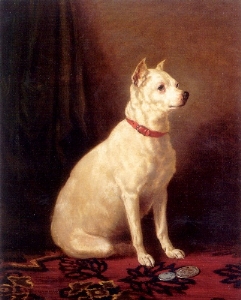
The English White Terrier is an extinct breed of dog. The English White Terrier is the failed show ring name of a pricked-ear version of the white fox-working terriers that have existed in Great Britain since the late 18th century.

The Westminster Pit was a well-known blood sport arena in nineteenth-century London, England. It reached a zenith of popularity between 1820 and 1830, and hosted such spectacles as dog-fighting, cock-fighting, bear-baiting, badger-baiting, monkey-baiting, and rat-baiting. A legal enterprise at the time, the Westminster Pit openly declared its activities, ushering notoriety on the district in which it existed.
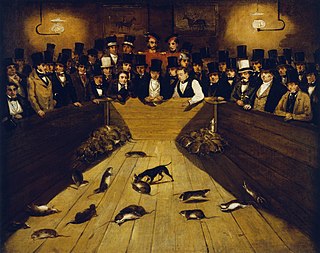
Tiny the Wonder was an English Toy Terrier famous in the City of London in the mid-19th century for being able to kill 200 rats in an hour in the city's rat-baiting pits. At the time, the world record for killing 100 rats was 5 minutes, 30 seconds, held by a bull and terrier named Billy.



















